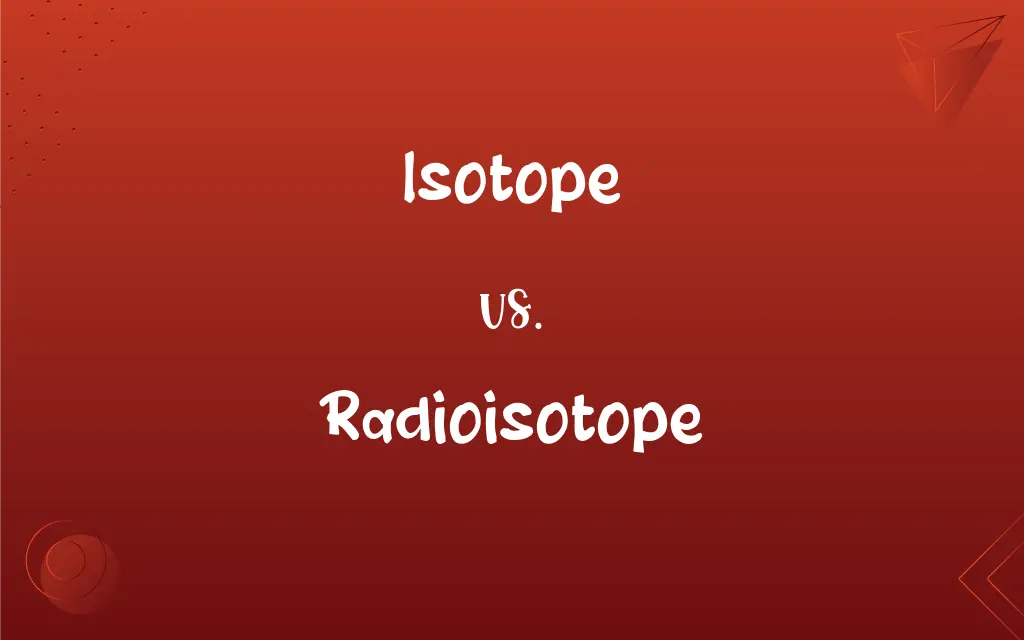Isotope vs. Radioisotope: What's the Difference?
Edited by Janet White || By Harlon Moss || Updated on October 23, 2023
Isotopes are variants of an element differing in neutron number; radioisotopes are unstable isotopes emitting radiation as they decay.

Key Differences
Isotopes are atoms of the same element that have the same number of protons but different numbers of neutrons. This means they possess the same atomic number but differ in mass number. Radioisotopes, on the other hand, are a subset of isotopes that have unstable nuclei. Their instability causes them to emit radiation, leading to a more stable state.
The concept of isotopes plays a foundational role in the field of chemistry. Understanding the variations in atomic mass of an element allows scientists to better study and predict its behavior. Radioisotopes have found diverse applications, from medicine to archaeology, due to their radioactive properties.
While every element on the periodic table can have multiple isotope forms, not all of them possess a radioisotope variant. Stable isotopes don't undergo radioactive decay and don't emit radiation, whereas radioisotopes do.
The presence of isotopes is natural, and they can be found abundantly in nature. For instance, carbon has two stable isotopes: carbon-12 and carbon-13. Radioisotopes, such as carbon-14, are often present in smaller amounts, due to their tendency to decay over time into more stable forms.
Comparison Chart
Definition
Atoms of the same element with different neutrons
Isotopes with unstable nuclei emitting radiation
ADVERTISEMENT
Stability
Can be stable or unstable
Always unstable
Radioactive Decay
Not always
Yes
Presence in Nature
Abundant
Less common due to decay
Applications
Chemistry, physics research
Medicine, archaeology, dating, industry
Isotope and Radioisotope Definitions
Isotope
Atomic forms of an element with varying atomic weights.
Isotopes of hydrogen include protium, deuterium, and tritium.
ADVERTISEMENT
Radioisotope
An isotope with an unstable nucleus that emits radiation during decay.
Technetium-99m is a radioisotope used in medical imaging.
Isotope
Variants of an element differing in neutron count.
The difference in neutrons makes helium-3 and helium-4 distinct isotopes.
Radioisotope
Isotopes that release alpha, beta, or gamma radiation to attain stability.
Iodine-131, a radioisotope, is utilized in thyroid cancer treatments.
Isotope
Naturally occurring or artificially produced forms of an element with different neutron quantities.
Isotopes of uranium are used in nuclear power generation.
Radioisotope
A radioactive form of an element undergoing nuclear transformation.
The radioisotope carbon-14 is vital in radiocarbon dating.
Isotope
Atoms of an element with the same atomic number but different mass numbers.
Carbon-12 and carbon-13 are both isotopes of carbon.
Radioisotope
Atoms with unstable nuclei that discharge energy and particles.
Radioisotopes are crucial for several industrial applications, including leak detection.
Isotope
Atoms that share the same number of protons but have varying numbers of neutrons.
Isotopes can provide insight into the behavior of elements in various conditions.
Radioisotope
Variants of an element that, due to nuclear instability, emit radiation.
Radioisotopes in smoke detectors can save lives by detecting fires early.
Isotope
One of two or more atoms having the same atomic number but different mass numbers.
Radioisotope
A naturally or artificially produced radioactive isotope of an element.
Isotope
(nuclear physics) Any of two or more forms of an element where the atoms have the same number of protons, but a different number of neutrons within their nuclei. Thus, isotopes have the same atomic number but a different mass number.
Radioisotope
(physics) a radioactive isotope of an element
Isotope
To define or demonstrate an isotopy of (one map with another).
Radioisotope
A radioactive isotope of an element; produced either naturally or artificially
Isotope
One of two or more atoms with the same atomic number but with different numbers of neutrons
FAQs
What defines an isotope?
An isotope is defined by the same number of protons but a different number of neutrons.
How are radioisotopes produced?
Radioisotopes are often produced in nuclear reactors or particle accelerators.
Can isotopes change into one another?
While isotopes can't change via chemical reactions, certain unstable isotopes can decay into others.
How are isotopes distinguished from each other?
Isotopes are distinguished by their mass number, which accounts for protons and neutrons.
Are isotopes naturally occurring?
Some isotopes are naturally occurring, while others are artificially produced.
Are radioisotopes used in food preservation?
Yes, radioisotopes are sometimes used to irradiate and preserve certain foods.
Do radioisotopes pose environmental risks?
If not managed properly, radioisotopes can pose risks to the environment and living organisms.
What are common uses of radioisotopes in medicine?
Radioisotopes are used in diagnostic imaging, cancer treatments, and sterilization.
What determines the type of radiation a radioisotope emits?
The nucleus's instability and its decay process determine a radioisotope's radiation type.
How are isotopes named?
Isotopes are typically named by their element followed by their mass number, e.g., carbon-12.
How can one identify different isotopes of an element?
Isotopes can be identified using mass spectrometry or other analytical techniques.
Why are isotopes important in chemistry?
Isotopes allow chemists to study element behavior, reaction kinetics, and molecular structures.
Are isotopes of the same element chemically different?
Isotopes of the same element behave almost identically chemically but can differ physically.
Why are radioisotopes used in cancer treatment?
Radioisotopes can target and kill cancer cells with radiation, limiting damage to surrounding healthy tissue.
What's the significance of isotopes in paleoclimatology?
Isotopes help in reconstructing past temperatures and environmental conditions.
Are all radioisotopes harmful?
Not all radioisotopes are harmful; their effects depend on the type, energy, and duration of radiation exposure.
Do all elements have isotopes?
Yes, all elements have at least one isotope.
What precautions are taken when working with radioisotopes?
When working with radioisotopes, one should use shielding, handle with tongs, and monitor exposure levels.
What's the difference in half-life between isotopes and radioisotopes?
Stable isotopes don't have a half-life, while radioisotopes do, indicating their decay rate.
What industries utilize radioisotopes extensively?
The medical, industrial, agricultural, and research sectors utilize radioisotopes extensively.
About Author
Written by
Harlon MossHarlon is a seasoned quality moderator and accomplished content writer for Difference Wiki. An alumnus of the prestigious University of California, he earned his degree in Computer Science. Leveraging his academic background, Harlon brings a meticulous and informed perspective to his work, ensuring content accuracy and excellence.
Edited by
Janet WhiteJanet White has been an esteemed writer and blogger for Difference Wiki. Holding a Master's degree in Science and Medical Journalism from the prestigious Boston University, she has consistently demonstrated her expertise and passion for her field. When she's not immersed in her work, Janet relishes her time exercising, delving into a good book, and cherishing moments with friends and family.
































































